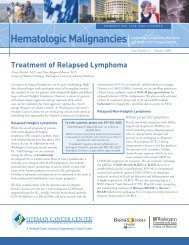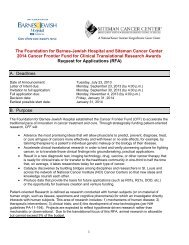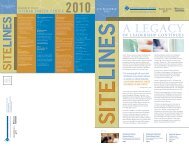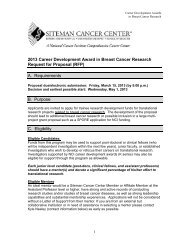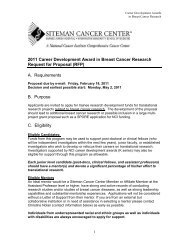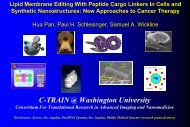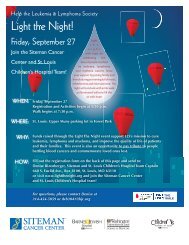Planting the Seeds of Prevention - Siteman Cancer Center
Planting the Seeds of Prevention - Siteman Cancer Center
Planting the Seeds of Prevention - Siteman Cancer Center
You also want an ePaper? Increase the reach of your titles
YUMPU automatically turns print PDFs into web optimized ePapers that Google loves.
Initially due to share results in 2013, PLCO investigators led by<br />
Andriole issued an early report in March 2009 stating that annual<br />
screening doesn’t appear to reduce deaths from prostate cancer among<br />
those with a limited life expectancy. “For men with a life expectancy<br />
<strong>of</strong> seven to 10 years or less, it’s probably not necessary to be screened<br />
for <strong>the</strong> disease,” Andriole says. But it’s too soon, he adds, to make<br />
broad recommendations for all men based on <strong>the</strong> study’s initial<br />
findings. “We don’t have enough data yet about <strong>the</strong> youngest men<br />
in <strong>the</strong> study — those in <strong>the</strong>ir 50s — and it may be that over time,<br />
we will in fact see a benefit from screening.”<br />
Ano<strong>the</strong>r big issue: “We can’t tell <strong>the</strong> difference between killer<br />
prostate cancer and slow-growing, nonkiller prostate cancer,”<br />
Andriole says. That uncertainty confounds treatment planning.<br />
To make <strong>the</strong> distinction, molecular studies by Adam Kibel, MD,<br />
pr<strong>of</strong>essor <strong>of</strong> surgery and assistant pr<strong>of</strong>essor <strong>of</strong> genetics, look for<br />
signatures in DNA that separate dangerous, fast-growing cancers<br />
Senior research technician Bill Wu prepares prostate cancer samples for from less threatening cases.<br />
high-throughput analysis as Adam Kibel, MD, looks on. In his research, Kibel, who also serves as director <strong>of</strong> urologic oncology, has<br />
Kibel is looking for genetic markers that could help distinguish<br />
identified a number <strong>of</strong> small changes in DNA, called polymorphisms,<br />
more deadly forms <strong>of</strong> prostate cancer from less aggressive ones.<br />
that might be reliable markers for prostate cancer. He is examining<br />
three cohorts <strong>of</strong> patients for <strong>the</strong> presence <strong>of</strong> those polymorphisms: 3,000 men in <strong>the</strong> PLCO<br />
trial, to see if <strong>the</strong>re is a concordance between prostate cancer and any <strong>of</strong> <strong>the</strong> DNA changes;<br />
800 to 1,000 men in a Johns Hopkins University study <strong>of</strong> metastatic disease, to see if any <strong>of</strong> <strong>the</strong><br />
polymorphisms are associated with aggressive prostate cancer; and all newly diagnosed cases<br />
at <strong>Siteman</strong>. From <strong>the</strong>se patients, Kibel also collects dietary and environmental information to<br />
find any differences among <strong>the</strong>m that ameliorate <strong>the</strong> disease. “The goal is not only to tell men if<br />
<strong>the</strong>y are at high risk for prostate cancer but also to tell <strong>the</strong>m how to decrease that risk,” he says.<br />
12 The Alvin J. <strong>Siteman</strong> <strong>Cancer</strong> <strong>Center</strong><br />
On <strong>the</strong> prevention front, it was thought that vitamin E and selenium might have a<br />
suppressive effect on prostate cancer development. But surprisingly, <strong>the</strong> SELECT clinical trial,<br />
in which Andriole was involved, recently closed with <strong>the</strong> finding that nei<strong>the</strong>r supplement reduces<br />
a man’s chance <strong>of</strong> getting <strong>the</strong> disease. Ano<strong>the</strong>r study directed by Andriole — <strong>the</strong> REDUCE trial<br />
— evaluated <strong>the</strong> preventive power <strong>of</strong> dutasteride, a drug widely prescribed to shrink enlarged<br />
prostates. Worldwide, 8,200 men at high risk for prostate cancer took part. The study, funded<br />
by dutasteride manufacturer GlaxoSmithKline, showed <strong>the</strong> drug lowered prostate cancer risk<br />
by 23 percent, an encouraging result, says Andriole, a consultant for <strong>the</strong> company.<br />
Andriole still recommends screening, even though <strong>the</strong> odds <strong>of</strong> dying from <strong>the</strong> disease are<br />
slim. “It’s better to know what’s going on in your prostate,” he says. “I’d ra<strong>the</strong>r know and make<br />
an informed decision about what course to take, whe<strong>the</strong>r that’s watchful waiting or aggressive<br />
treatment, than stick my head in <strong>the</strong> sand and hope everything turns out all right.”



